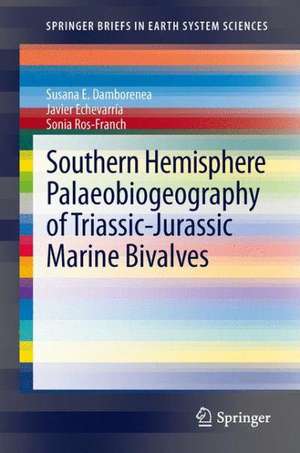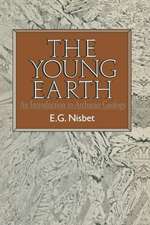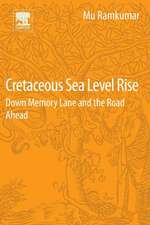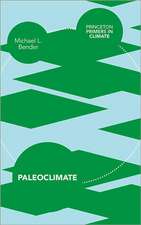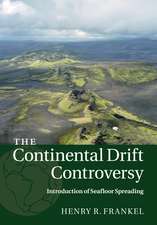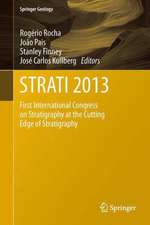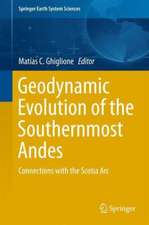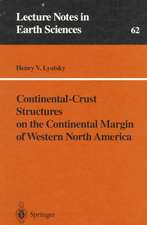Southern Hemisphere Palaeobiogeography of Triassic-Jurassic Marine Bivalves: SpringerBriefs in Earth System Sciences
Autor Susana E. Damborenea, Javier Echevarría, Sonia Ros-Franchen Limba Engleză Paperback – 27 sep 2012
palaeobiogeography, these organisms also provide interesting insight into particular biogeographical questions, such as bipolarity and its origin. The evolution in time of the
recognized biochoremas can be discussed in relation to palaeoclimas and extinction events. Finally, some of the results obtained from the analysis of the distribution of past
bivalve biotas were even used to propose and discuss the development of marine corridors and argue about the distribution of continents in the past.
Din seria SpringerBriefs in Earth System Sciences
-
 Preț: 379.09 lei
Preț: 379.09 lei -
 Preț: 260.95 lei
Preț: 260.95 lei -
 Preț: 424.71 lei
Preț: 424.71 lei -
 Preț: 378.54 lei
Preț: 378.54 lei -
 Preț: 380.07 lei
Preț: 380.07 lei -
 Preț: 376.22 lei
Preț: 376.22 lei -
 Preț: 377.57 lei
Preț: 377.57 lei -
 Preț: 379.48 lei
Preț: 379.48 lei -
 Preț: 379.09 lei
Preț: 379.09 lei -
 Preț: 377.35 lei
Preț: 377.35 lei -
 Preț: 379.09 lei
Preț: 379.09 lei -
 Preț: 259.57 lei
Preț: 259.57 lei -
 Preț: 376.80 lei
Preț: 376.80 lei -
 Preț: 377.73 lei
Preț: 377.73 lei -
 Preț: 379.86 lei
Preț: 379.86 lei -
 Preț: 381.00 lei
Preț: 381.00 lei -
 Preț: 140.77 lei
Preț: 140.77 lei -
 Preț: 380.07 lei
Preț: 380.07 lei -
 Preț: 262.47 lei
Preț: 262.47 lei -
 Preț: 377.18 lei
Preț: 377.18 lei -
 Preț: 260.56 lei
Preț: 260.56 lei -
 Preț: 376.22 lei
Preț: 376.22 lei -
 Preț: 377.18 lei
Preț: 377.18 lei -
 Preț: 348.79 lei
Preț: 348.79 lei -
 Preț: 378.12 lei
Preț: 378.12 lei -
 Preț: 379.09 lei
Preț: 379.09 lei -
 Preț: 376.59 lei
Preț: 376.59 lei -
 Preț: 375.23 lei
Preț: 375.23 lei -
 Preț: 376.04 lei
Preț: 376.04 lei -
 Preț: 443.58 lei
Preț: 443.58 lei -
 Preț: 384.48 lei
Preț: 384.48 lei -
 Preț: 377.95 lei
Preț: 377.95 lei -
 Preț: 376.59 lei
Preț: 376.59 lei -
 Preț: 350.18 lei
Preț: 350.18 lei -
 Preț: 379.68 lei
Preț: 379.68 lei -
 Preț: 378.71 lei
Preț: 378.71 lei -
 Preț: 378.12 lei
Preț: 378.12 lei -
 Preț: 376.96 lei
Preț: 376.96 lei -
 Preț: 377.35 lei
Preț: 377.35 lei -
 Preț: 374.30 lei
Preț: 374.30 lei -
 Preț: 377.73 lei
Preț: 377.73 lei -
 Preț: 378.34 lei
Preț: 378.34 lei -
 Preț: 378.54 lei
Preț: 378.54 lei -
 Preț: 412.89 lei
Preț: 412.89 lei -
 Preț: 375.62 lei
Preț: 375.62 lei -
 Preț: 341.97 lei
Preț: 341.97 lei -
 Preț: 379.09 lei
Preț: 379.09 lei -
 Preț: 375.23 lei
Preț: 375.23 lei -
 Preț: 377.35 lei
Preț: 377.35 lei
Preț: 380.07 lei
Nou
Puncte Express: 570
Preț estimativ în valută:
72.73€ • 78.98$ • 61.10£
72.73€ • 78.98$ • 61.10£
Carte tipărită la comandă
Livrare economică 22 aprilie-06 mai
Preluare comenzi: 021 569.72.76
Specificații
ISBN-13: 9789400750975
ISBN-10: 9400750978
Pagini: 100
Ilustrații: VIII, 139 p. 47 illus., 34 illus. in color.
Dimensiuni: 155 x 235 x 15 mm
Greutate: 0.23 kg
Ediția:2013
Editura: SPRINGER NETHERLANDS
Colecția Springer
Seria SpringerBriefs in Earth System Sciences
Locul publicării:Dordrecht, Netherlands
ISBN-10: 9400750978
Pagini: 100
Ilustrații: VIII, 139 p. 47 illus., 34 illus. in color.
Dimensiuni: 155 x 235 x 15 mm
Greutate: 0.23 kg
Ediția:2013
Editura: SPRINGER NETHERLANDS
Colecția Springer
Seria SpringerBriefs in Earth System Sciences
Locul publicării:Dordrecht, Netherlands
Public țintă
ResearchCuprins
Introduction.-
-Paleobiogeography and neobiogeography.-
-Why bivalves?.-
-Time frame.-
-Paleogeography.-
-Paleoclimates and water temperatures.-
-Paleocurrents.-
Techniques.-
-The data.-
-Quantification: a difficult approach.-
-Analytic methods.-
A bivalve perspective.-
-Previous research: a northern hemisphere affair.-
-Some general issues.-
-Paleobiogeographic affinities.-
Regional scale.-
-Facies and bivalve distributions: examples from the Neuquén Basin.-
-Latitudinal gradients.-
-Distribution patterns and boundaries.-
Hemispheric scale.-
-Data.-
-Biochoreme recognition.-
-Evolution of biochoremas.-
-Evolution of biochoreme boundaries and its causes.-
-Congruence.-
-Paleobiogeographic units and mass extinctions.
Global scale.-
-Bipolarity.-
-Seaways: the Hispanic Corridor.-
-Oceanic currents.-
-Evolution of global biochoreme boundaries.
-Paleobiogeography and neobiogeography.-
-Why bivalves?.-
-Time frame.-
-Paleogeography.-
-Paleoclimates and water temperatures.-
-Paleocurrents.-
Techniques.-
-The data.-
-Quantification: a difficult approach.-
-Analytic methods.-
A bivalve perspective.-
-Previous research: a northern hemisphere affair.-
-Some general issues.-
-Paleobiogeographic affinities.-
Regional scale.-
-Facies and bivalve distributions: examples from the Neuquén Basin.-
-Latitudinal gradients.-
-Distribution patterns and boundaries.-
Hemispheric scale.-
-Data.-
-Biochoreme recognition.-
-Evolution of biochoremas.-
-Evolution of biochoreme boundaries and its causes.-
-Congruence.-
-Paleobiogeographic units and mass extinctions.
Global scale.-
-Bipolarity.-
-Seaways: the Hispanic Corridor.-
-Oceanic currents.-
-Evolution of global biochoreme boundaries.
Notă biografică
Dr. Susana E. Damborenea has studied Natural Sciences (Geology) at the University of La Plata, Argentina, and at the University of Wales. She has had several teaching positions at the Facultad de Ciencias Naturales y Museo of the Universidad Nacional de La Plata, Argentina. Her present position is Professor of Invertebrate Palaeontology at La Plata University, Argentina. She teaches graduate and postgraduate courses on Palaeontology. Her research interests include invertebrate palaeontology, Mesozoic South American molluscs (especially Jurassic of Argentina), bivalve systematics, biostratigraphy, palaeoecology of marine environments and palaeobiogeography of southern Hemisphere regions.
Textul de pe ultima copertă
Palaeobiogeography is a complex subject which processes information provided by both Biology and Earth Sciences. It is conceptually and philosophically equivalent to neobiogeography. Nevertheless, its methods are somewhat different, since it is limited by the incompleteness of the fossil record. On the other hand, it has direct access to the time dimension, a key ingredient of organic evolution. Mesozoic benthonic mollusks, and especially bivalves, have a great potential for palaeobiogeographical analysis due to their commonly good preservation, abundance, diversity and high dispersion potential at the larval stage. From a merely descriptive point of view, the analysis of their distribution shows latitudinal gradients and distributional patterns, both at regional and global scales, which are the basis for the recognition of biochoremas or palaeobiogeographical units of different ranks. Moving forward towards a causal palaeobiogeography, these organisms also provide interesting insight into particular biogeographical questions, such as bipolarity and its origin. The evolution in time of the recognized biochoremas can be discussed in relation to palaeoclimas and extinction events. Finally, some of the results obtained from the analysis of the distribution of past bivalve biotas were even used to propose and discuss the development of marine corridors and argue about the distribution of continents in the past.
Caracteristici
Includes supplementary material: sn.pub/extras
